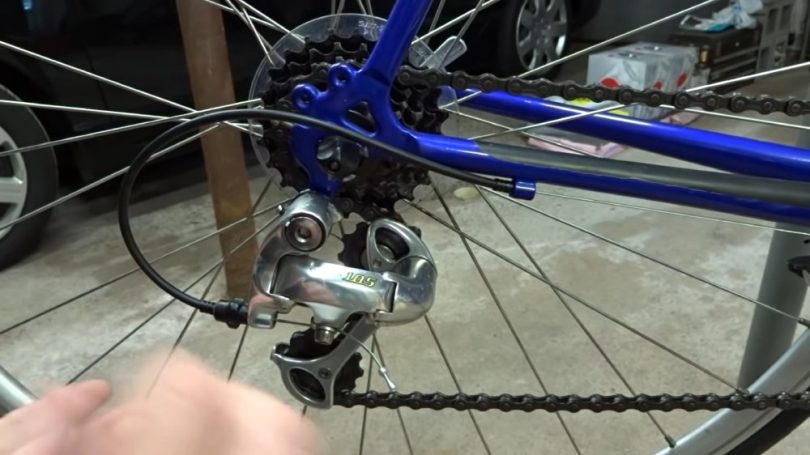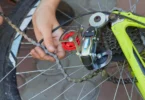Chain skips, or “ghost shifts” are dangerous and can cause some serious damage to your body and your bike. Bike repair isn’t cheap either, with some damage leading to big repair bills and replacement parts. Chain skips can lead to some expensive damage to the most important parts of your bike, so it’s important that we prevent it from happening.
Lucky for us, discovering and repairing the problems that cause chain skips doesn’t require a professional. Here we’ll be showing you what could be causing chain skips and how to fix each problem step-by-step.
Your Derailleur Needs to be Adjusted
The derailleur is the main component for gear shifting on a bike, so it’s more than likely that the chain skips occur due to some problem with the derailleur.
Possible Causes
1. Bent derailleur hangar
Cause
The hangar of the derailleur can get bent in a number of ways, especially if you are riding on hard terrain or going fast. If it’s bent, then the gear shifter isn’t going to work properly.
Solution
- Take a pair of pliers and gently re-align the part that is bent.
- This is only a temporary fix, however. Even if you fix the bend, the gears will have been misaligned, so it’s actually best to replace it for the long term.
2. Rusty cables
Cause
Cables in the derailleur will rust over time and get stuck, causing chain skips.
Solution
- You will need some chain oil and rust remover for this.
- Apply the rust remover to the rusty part of the cables.
- Wipe away the rust.
- Put chain oil along the cable then, gently pull to reach all of the cable’s length.
3. Limit screws out of position
Cause
In the worst-case scenario, the limit screws and cables can be out of position. This is usually caused if the previous two causes happen first.
Solution
- For this, you’ll need an Allen key, an alignment gauge, and some rubbing alcohol.
- Use the Allen key to loosen and detach the derailleur.
- Wipe the hangar clean with the rubbing alcohol.
- Attach the alignment gauge to the hangar by threading it on.
- Once the gauge is secure, find the level indicator. This will tell you when the alignment is correct.
- Turn the gauge to the right until it’s pointing right.
- If the indicator is parallel, stick the indicator pin in and lock the slider.
- Turn the gauge clockwise again until it’s pointing down.
- Again, once everything is parallel on the indicator, lock the slider into place.
- Repeat until you’ve done a full rotation.
- Detach the gauge, then re-attach the derailleur using the Allen key.
The Bike Chain Is Skipping Teeth on the Cog
If the chain starts skipping teeth, riding uphill is pretty much impossible and you will quickly lose control of the bike. Once you lose control, injury is inevitable.
Possible Causes
1. The chain is worn
Cause
Chains are meant to be replaced. For them to work, they are constantly grinding against the cogs, slowly wearing down the more use the bike gets. When the chain wears down, it won’t lock into the cog teeth and chain skips occur.
Solution
By the time your bike skips, the chain is beyond repair and needs to be replaced with a new one. To make your chain last longer, clean and lubricate the chain regularly.
2. The cogs are worn
Cause
Just like the chain, metal from the cogs slowly wears away. In this case, the cog teeth will be too short and miss the chain.
Solution
Wear to the cogs is actually caused by the chain, so as long as you maintain the chain, the cogs will last a long time.
3. A chain link is stuck
Cause
Mainly caused by rust and no lubrication, the links in a chain will get stuck on the cog or derailleur. However, it can also be caused by intense riding. The pressure and weight from your body can bend a link if pushed too hard.
Solution
- For this method, you’ll need a chain tool. This tool lets you remove individual chain links without fuss and doesn’t damage the link. Make sure you use the correct size tool for your bike. You’ll also need some kind of all-purpose cleaner and a lubricant.
- Turn the handle of the chain tool counter-clockwise, then fit the chain into the gap.
- Push the chain pin out by turning the chain tool handle into its space. You be extremely cautious when doing this because the chain’s pin mustn’t fall out of the chain. If the pin is halfway through or you start to feel resistance, it’s fine.
- Remove the link from the tool.
- Clean the link with the all-purpose cleaner.
- Put the link back into place in the tool.
- Turn the chain tool handle counter-clockwise until the chain pin is back in place.
- Go over any other links that are stuck.
FAQs
1. How much does it cost to replace a bike chain?
Ans. The average cost is between $25 to $50. If you want a bike repair shop to install it, it can be up to $120.
2. What happens when your bike chain skips?
Ans. You will lose the ability to shift gears properly, which leads to your bike losing speed control and navigation. It can be a disaster for the rider.







